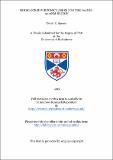Modelocked vibronic lasers for the 700nm - 1000nm region
Abstract
The work in this thesis is concerned with the characterisation and development of modelocked solid-state lasers covering the 700 - 1000 nm region. Results are presented for a passively modelocked LiF:F+2 colour-centre laser, however, most of the work has concentrated on the Ti: sapphire (Ti:Al2O3) laser. In chapter 2, the operation of a cw LiF: F+2 colour-centre laser is discussed. This laser was passively modelocked using the saturable absorber dye, DaQTeC and pulses as short as 170 fs were generated with average output powers of ~10 mW. Pulses as short as 127 fs were generated in a dispersion compensated, colliding-pulse modelocked geometry over a wavelength range of 925 - 950 nm. A nonlinear external cavity was added to the basic laser configuration in an attempt to extend the modelocked tuning range and the saturable absorber dye lifetime. The technique of coupled-cavity modelocking was applied to a Ti:Al2O3 laser and enabled pulses as short as 1.3 ps to be generated. These pulses were frequency chirped and could be directly compressed to 290 fs outside the laser. By using the technique of intracavity dispersion compensation in both the main and coupled cavities, pulses as short as 90 fs were generated, having average powers of ~200 mW and peak powers of more than 20 kW. The simpler technique of self-modelocking is described in chapter 5 and allowed the generation of pulses as short as 60 fs from a dispersion compensated cavity configuration. Average output powers of ~600 mW were measured, which corresponded to peak powers of 110 kW. This laser had a modelocked tuning range which spanned the 750 - 950 nm region. Using fibre/prism pulse compression techniques pulses as short as 45 fs were produced. In chapter 6, the measurement and suppression of phase noise on the self-modelocked Ti:Al2O3 laser are discussed. The technique for noise reduction was also applied to two similar self-modelocked lasers in an attempt to synchronise the two laser pulse sequences.
Type
Thesis, PhD Doctor of Philosophy
Collections
Items in the St Andrews Research Repository are protected by copyright, with all rights reserved, unless otherwise indicated.

